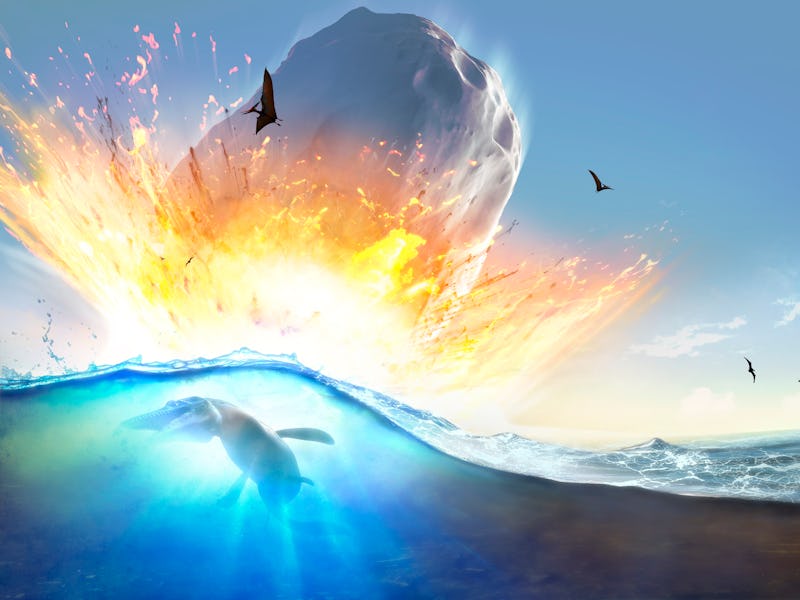Old dirt tells new story about dinosaur mass extinction event
The true havoc wreaked by the asteroid behind the dinosaur die-off is becoming ever clearer.

Off the coast of Mexico, the Chicxulub crater is all that remains of a defining moment in Earth's history. The hole spans 93 miles wide and bores 12 miles deep into the Earth. It was left by an asteroid or comet — the same one that wiped out 70 percent of living species during the Late Cretaceous.
Now, some 66 million years on, charred remains within the crater sediment tell a new story of what really happened during the dinosaur-eliminating event.
Burned sediment near the Chicxulub crater may hold the key to understanding the conditions on Earth that led to the mass extinction event. The authors of a new paper studied chemical markers in the sediment, finding evidence of what exactly led to the dramatic die-off.
"These materials could be derived from wildfires on land or from sedimentary rocks hit by the asteroid," write the authors of the study, published on Monday in the journal Proceedings of the National Academy of Sciences.
To determine the source of the burned material — black carbon — the researchers analyzed sediment from the Chicxulub crater as well as ocean sediment samples taken far from the crater's mouth. They focused on a group of hydrocarbons called PAHs, or polycyclic aromatic hydrocarbons.
Analyzing the chemical composition of the sediment, the researchers found evidence suggesting that black carbon came from a fossil source, not from global wildfires. The PHA characteristics suggest that the substance was the product of rapid heating, and they are consistent with rocks ejected during the asteroid impact.
The samples also contained charcoal — the product of burning biomass like trees.
The findings suggest wildfires did occur after the asteroid hit, but they were probably delayed, and ultimately had a smaller influence on the global climate and animal extinction.
Circling the globe — In all, the aftermath of the asteroid event released between 7.5 x 1014 and 2.5 x 1015 grams of black carbon into the atmosphere. Those particles didn't stay local for long. They moved around the planet quickly, combining with dust and aerosols.
"Recent simulations demonstrate that interactions between Chicxulub ejecta and the Earth’s atmosphere led to the generation of a fast-moving dust cloud that traveled above the stratosphere and circled the globe within a few hours of the impact," the study authors write. "[T]his material gradually settled into the stratosphere under Earth’s gravity circled the planet."
In turn, the "dust cloud" darkened and cooled Earth, a phenomenon known as an impact winter. Those harsh conditions led to "an abrupt reduction in photosynthesis," the researchers say, driving the mass extinction event at the end of the Cretaceous that wiped out most animals living on Earth.
Thanks to this new analysis, scientists have a better idea of what happened after the infamous asteroid's burned byproducts were released.
"[B]urn products from the impact site acted to intensify both the inhibition of photosynthesis and global cooling during the mass extinction," the authors write, "while wildfires had a delayed impact and increased the magnitude and duration of the impact winter."
Abstract: An asteroid impact in the Yucatán Peninsula set off a sequence of events that led to the Cretaceous–Paleogene (K–Pg) mass extinction of 76% species, including the nonavian dinosaurs. The impact hit a carbonate platform and released sulfate aerosols and dust into Earth’s upper atmosphere, which cooled and darkened the planet—a scenario known as an impact winter. Organic burn markers are observed in K–Pg boundary records globally, but their source is debated. If some were derived from sedimentary carbon, and not solely wildfires, it implies soot from the target rock also contributed to the impact winter. Characteristics of polycyclic aromatic hydrocarbons (PAHs) in the Chicxulub crater sediments and at two deep ocean sites indicate a fossil carbon source that experienced rapid heating, consistent with organic matter ejected during the formation of the crater. Furthermore, PAH size distributions proximal and distal to the crater indicate the ejected carbon was dispersed globally by atmospheric processes. Molecular and charcoal evidence indicates wildfires were also present but more delayed and protracted and likely played a less acute role in biotic extinctions than previously suggested. Based on stratigraphy near the crater, between 7.5 × 1014 and 2.5 × 1015 g of black carbon was released from the target and ejected into the atmosphere, where it circulated the globe within a few hours. This carbon, together with sulfate aerosols and dust, initiated an impact winter and global darkening that curtailed photosynthesis and is widely considered to have caused the K–Pg mass extinction.